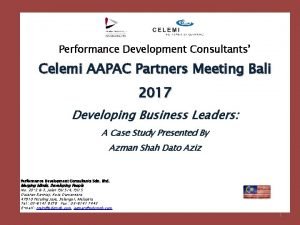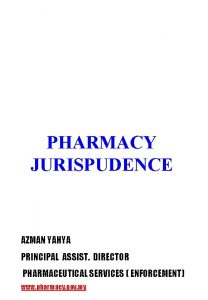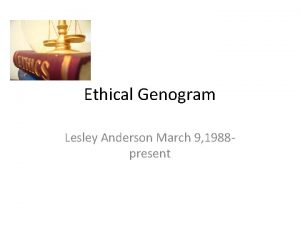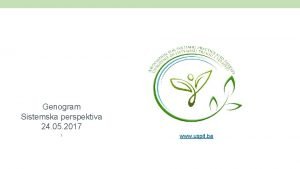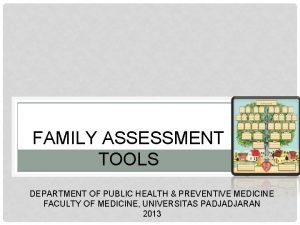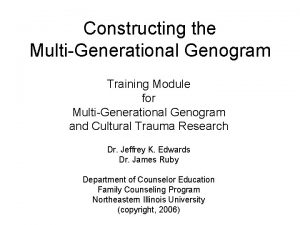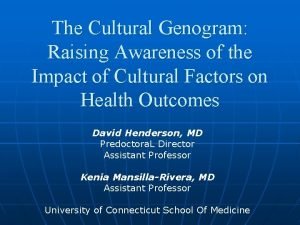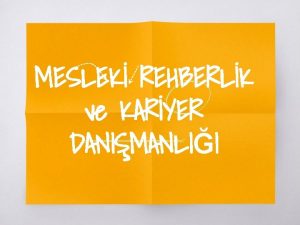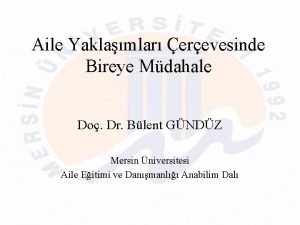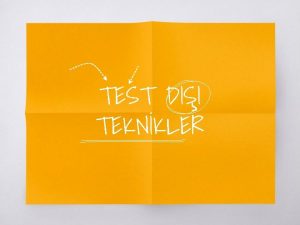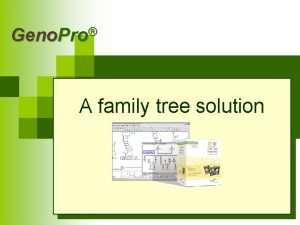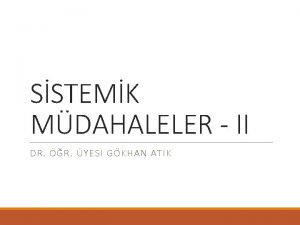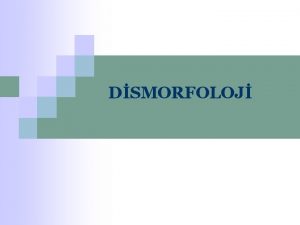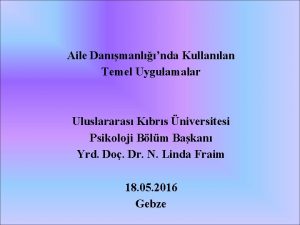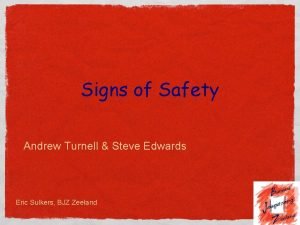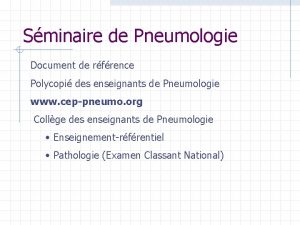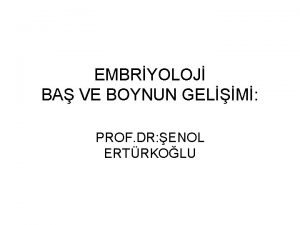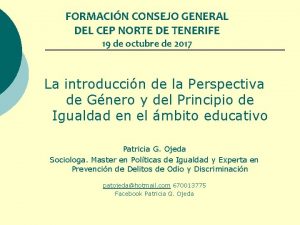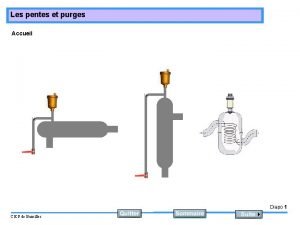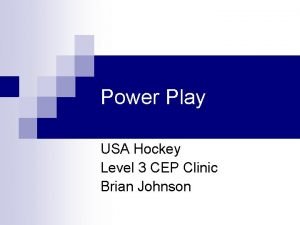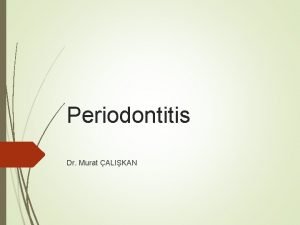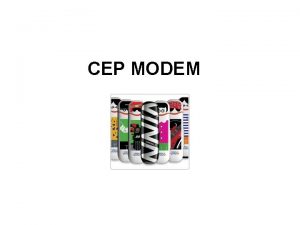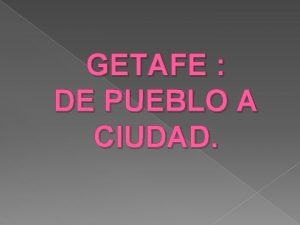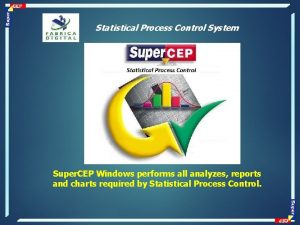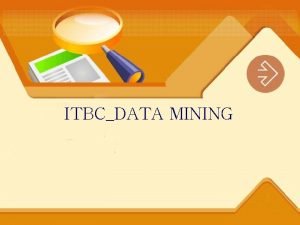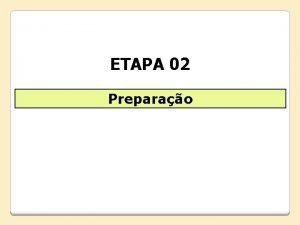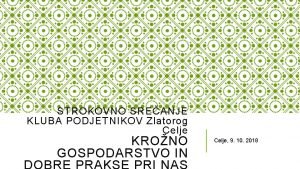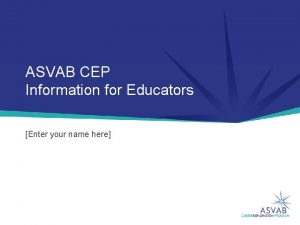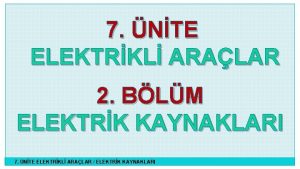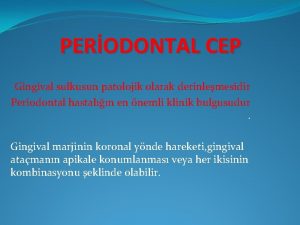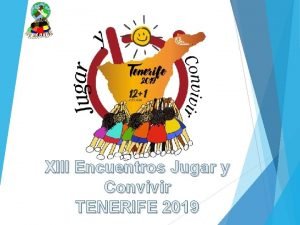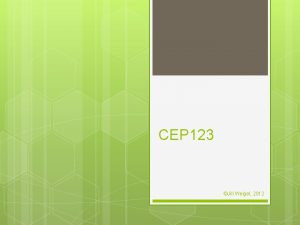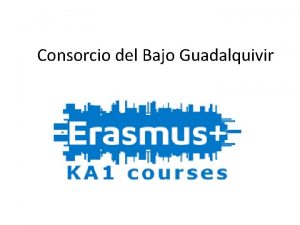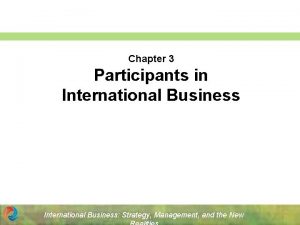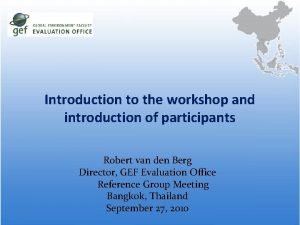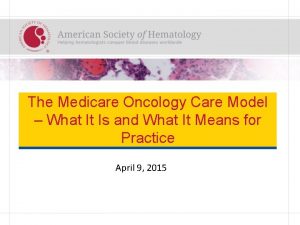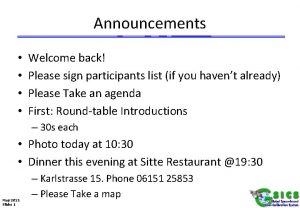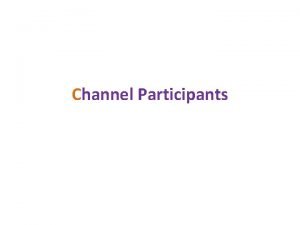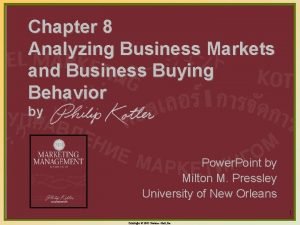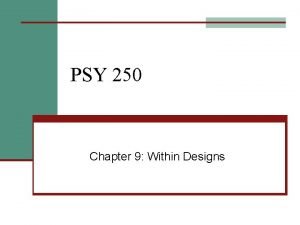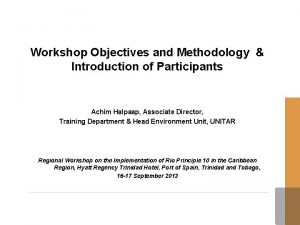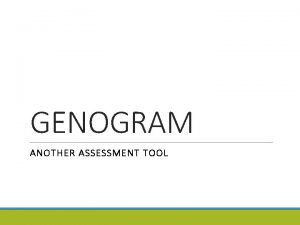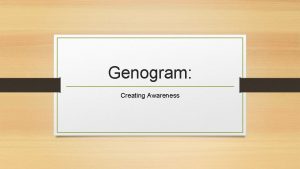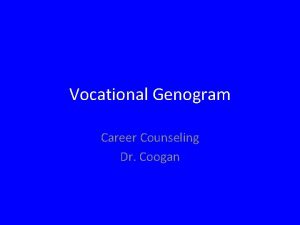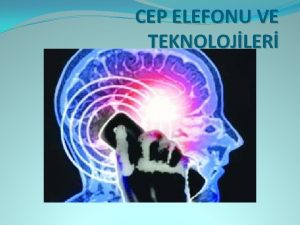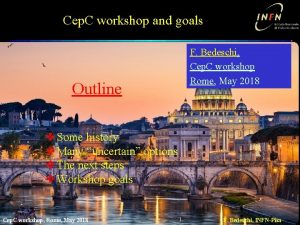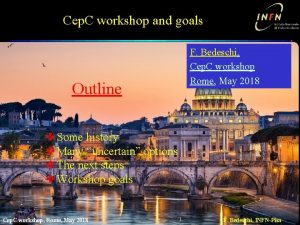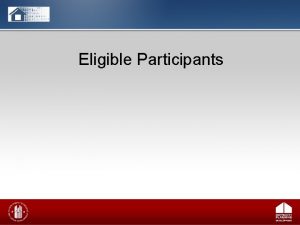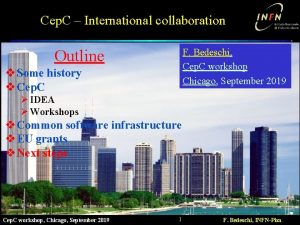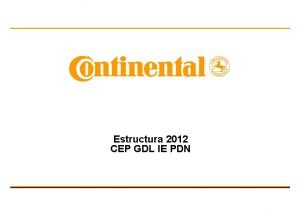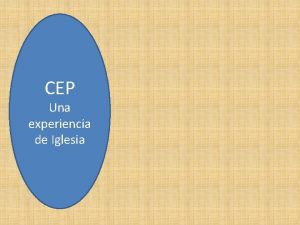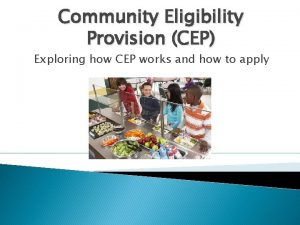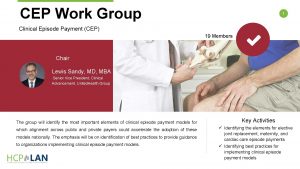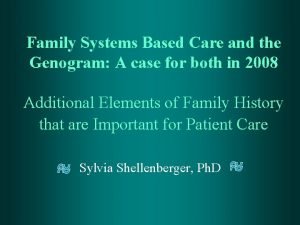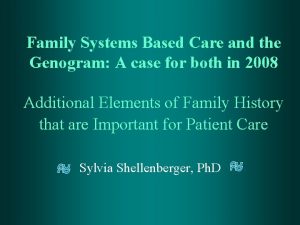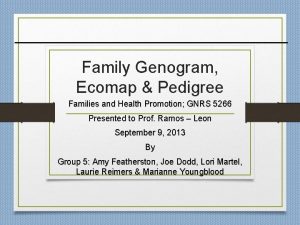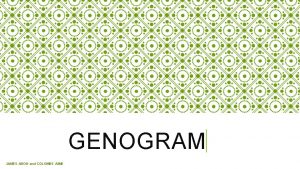GENOGRAM Azman Anuar Goals Participants in this CEP



























































- Slides: 59

GENOGRAM Azman Anuar

Goals Participants in this CEP will gain: • Knowledge on the construction of genogram and the common symbols used Disclaimer

Session’s outline 1. Introduction 2. 3 stages in drawing genogram a) Stating the demographic data i. Simple genogram ii. Complex genogram b) Reflecting the state of functioning of family members c) Drawing the relationships and roles 3. Genogram and Ecomap 4. Genogram as an interviewing tool 5. Genograms as an intervention tool

Source of information • Monica Mc. Goldrick, Randy Gerson and Sylvia Shellenberger (1999), 2 nd Edn, Genograms: Assessment and Interventions, W W Norton, USA. • Multicultural Family Institute (MFI), New Jersey website.

Confidentiality

Introduction Genogram is widely among those in the field of psychology, medicine, social work and other health care, human service and even legal fields. Genogram is known to be widely used by family therapists. It is a (family) therapist's version of a family tree. The organization of the genogram and its use of handy symbols permit therapist and the patient to quickly identify and understand patterns in family history.

Introduction Family therapist Monica Mc. Goldrick and her colleagues at the Multicultural Family Institute of New Jersey have pioneered the use of genograms as a diagnostic tool, and as a method of helping families see patterns within their past and present. To know more on the assumptions on the use of genograms in the family systems perspectives, read pg. 6, Monica Mc. Goldrick, Randy Gerson and Sylvia Shellenberger (1999), 2 nd Edn, Genograms: Assessment and Interventions, W W Norton, USA. It is still a tool in progress. Symbols are evolving. Standardization is developed by the North American Primary Care Research Group in collaboration with leading family therapists.

Business Genograms: A tool for understanding the family side of family business™ About the Program Any good consultation begins with a thoughtful and thorough assessment of the three family business circles: the family, the owners, and the business. This program is designed to develop family business advisors’ skills in assessing the family circle, using the genogram as a tool for mapping, exploring and understanding both the structural and process elements of a family system. The program includes detailed information about constructing genograms, as well as how to conduct both a structural and process analysis of the information. Case examples illustrate such key concepts as enmeshment, triangles, alliances, conflict groups, branch dynamics, birth order, and family developmental stages. In addition, workshop participants have an opportunity to create and reflect on their own family genogram. This personal exploration can be an opportunity to improve self-awareness about how our own family and life experience affects our professional work with families. Goals Participants in this seminar will gain: * Knowledge of how to use the genogram as a tool for assessing the structural and process elements of a family system. * Skills in assessing family dynamics and understanding their impact on the family business. * Understanding of how consultants’ perspectives can be influenced by their own family system dynamics. Source: Family Firm Institute, www. ffi. org

Family systems therapy Genogram • One of the best ways to begin therapy and to gain understanding of how the emotional system operates in a family system is to put together the family genogram. Studying the patterns of behavior, and how they relate to those multigenerational family, reveals new and more effective options for solving problems and for changing individual’s response to the automatic role one is expected to play.

Commonly drawn genogram (e. g. 1) 2 generations

Commonly drawn genogram (e. g. 2) 3 generations

Commonly drawn genogram (e. g. 4) 3 generations

Commonly drawn genogram (e. g. 3) 1 G 2 G 3 G 4 G 4 generations

Commonly drawn genogram (e. g. 5) 1 G 2 G 3 G 4 G Commonly drawn 4 generations genogram (e. g. 5)

Stages in genogram drawing Stages in drawing genogram There about three stages in drawing genogram. 1. Stating the demographic data 2. Reflecting the state of functioning of family members 3. Drawing the relationships and roles

Stages in drawing genogram Stage 1 Stating the demographic data a) b) c) d) e) f) g) h) i) j) Age Date of birth and death (cause of death) Marital/Relationship status Whereabouts (living arrangement) Income Occupation Education Ethnic Religious practices Trouble with the law

Standard Basic Symbols 43 43 Transgender People Gay Lesbian Bisexual Pet Man to woman Note: Pink/Black Tri Woman to man

Pink Triangle • • • As most everyone knows, the pink triangle is a symbol taken directly from the Nazi concentration camps. Usually when concentration camps and Nazis are mentioned, most people tend to think of Jews and the Jewish Holocaust (for good reason). But the fact that a large number of homosexual prisoners were in those same camps is an often ignored or overlooked fact of history. The real story behind the pink triangle begins prior to World War II. Paragraph 175, a clause in German law, prohibited homosexual relations (much like many states in the U. S. today have laws against "crimes of nature"). In 1935, during Hitler's rise to power, he extended this law to include homosexual kissing, embracing, and even having homosexual fantasies. An estimated 25, 000 people were convicted under this law between 1937 and 1939 alone. They were sent to prisons and later concentration camps. Their sentence also included sterilization, most commonly in the form of castration. In 1942, Hitler extended the punishment for homosexuality to death. Prisoners in Nazi concentration camps were labeled according to their crimes by inverted colored triangles. "Regular" criminals were denoted by a green triangle, political prisoners by red triangles and Jews by two overlapping yellow triangles (to form the Star of David, the most common Jewish symbol). Homosexual prisoners were labels with pink triangles. Gay Jews- the lowest form of prisoner- had overlapping yellow and pink triangles. This system also created a social hierarchy among the prisoners, and it has been reported that the pink triangle prisoners often received the worst workloads and were continually harassed and beaten by both guards and other prisoners.

Types of Relationships: Married Separation in fact EMA Legal

Types of Relationships: Not Married EMA

Basic Symbols for Order and Type of Birth Children: List in birth order beginning with the oldest on left

Sample of simple genogram – 2 G 18 15

complex genogram Multiple marriages and Divorces How do you reflect a family where parents (either one or both) are divorced and remarried? Is it like these? >>>

> >> is? th Or Is it lik e this? >>> Sample 1 of genogram showing multiple marriages

Sample 2 of genogram showing multiple marriages > > > ? s i h Or t

complex genogram Multiple marriages and Divorces How do you reflect a family where parents are divorced and remarried? i. Husband who has two previous failed marriages ii. Wife with two previous marriages and has one child from each marriage, including current marriage

Multiple marriages and Divorces: Husband with current and ex-wives 1 st 2 nd m ’ 81 d ‘ 86 m ’ 90 d ‘ 00 3 rd m ’ 02 Husband , his current wife and his ex-wives (who are shown lower and smaller). Husband’s wives may go on left to be closest to him. Indicators “ 1 st “, “ 2 nd” and “ 3 rd” etc make clear the order of his marriages.

Multiple marriages and Divorces: Wife with current and ex-husbands 1 st 2 nd m ’ 81 d ‘ 86 m ’ 90 d ‘ 00 22 16 3 rd m ’ 02 6 Wife, her current husband her ex-husbands (who are shown lower and smaller). Wives’ previous relationship are shown on left to keep children in birth order, since they remained in her custody.

complex genogram Multiple marriages and Divorces How do you reflect a family where parents are divorced and remarried? a. Both spouses have history of remarriages 1. Wife has previous two failed marriages , has one child in each marriage, age 14 (M ) and 9 (M) while husband has one failed marriage with a son age 8. They have a son, age 3, from current marriage. They were married in 2002. 2. Wife has three failed marriages and only one son from the 3 rd marriage. Husband has 4 failed marriages , one child each from 2 nd (26/M), 3 rd (16/M) and 4 th (11/M) marriage. From their current marriage, they have a 2 yr old son. Married in 2002.

Multiple marriages and Divorces: with current and ex-spouses 1 st m ’ 02 m ’ 94 d ‘ 99 97 - 02 - 8 3 1 st m ’ 90 d’ 92 91 - 14 2 nd m ’ 94 d ‘ 98 96 - 9 Yr 2005 Couple with three year old son, showing their previous spouses (smaller symbols) and those spouses’ new partners (even smaller symbols)

Multiple marriages and Divorces: with current and ex-spouses, children and living arrangement 55 - 65 - 50 40 1 st m ’ 85 d ‘ 89 m ’ 77 d ‘ 80 2 nd m ’ 81 d ‘ 86 m ’ 90 d ‘ 93 3 rd m ’ 87 d ‘ 90 m ’ 02 4 th m ’ 94 d’ 99 m ’ 92 d ‘ 97 82 - 89 - 23 16 94 - 11 03 - 2 95 - 10 Yr 2005 Couple living with their joint child and wife’s child from previous marriage. The other spouses of the partners are shown smaller and lower on either side of the present household. How do we show custody over children?

Adding more information: Income, education, occupation and place of living Income is written above the birth and death date. (my preference: to state it below the occupation) Include the education and occupation near the name. The person’s place of living should be written at the top of the line connecting the symbols. $20 K/m 40 -’ 99 $15 K/m 57 - 59 50 T Bo Lee Surgeon W SL Doctor m. ‘ 76 NY $8 K/m 77 - $? K/m 81 - 30 26 T Ah Lee Ph. D/Psych Lecturer T Oh Lee Degree/ Journalist UK 83 - 24 T Er Lee Undergraduate

Stages in genogram drawing Stages in drawing genogram Stage 2 Reflecting the state of functioning of family members This means including data such as a) Medical b) Emotional c) Behavioural (working history, drinking pattern, etc) Look out for patterns of functions within and across generations such as a. Substance abuse b. Incest c. Violence d. Suicide, etc Noting these may help to understand the client’s current adaptation to the situation and may provide ideas on how to address it.

Symbols denoting addiction/substance abuse and medical or physical illness Substance Abuse Mental or physical problems Lightly shaded or striped Other problems Smoker S Obesity O L Language problem In recovery from substance abuse and mental or physical problems

Types of Medical Conditions: just for information only

Other information: Significant Institutional relationship Name Edn Occupation Therapist Depression Date/yr depression on medication 18 Name Edn Occupation Counsellor Depression Date/yr SAF Psychiatrist 15 Name Edn Occupation Drug Rehab Ctr 1 st offence Depression Date/yr Her, K, Date/yr

Sample of genogram with substance, medical and physical problems

$1200 35 - High blood P Diabetic LSemi-ambulant Name Edn? Housewife 65 65 Name Edn? Artisan UK UK $? 60 - $0 63 - depression on medication 48 Norman /English Edn? Job? m. 85 s. ’ 00 d. ‘ 02 depression on medication SAF Psychiatrist Counsellor 45 Norma /Malay Edn? Unemployed UK 87 - 3 -room flat, HDB $0 35 - ? ? 87 - 90 - 18 MGF GCE ‘A’ Student 16 IDR GCE ‘O’ Student 19 Name Edn? NSF 18 Name Schooling 90 - 87 - 4 2 Name 2005

Stages in genogram drawing Stages in drawing genogram Stage 2 Drawing the relationships and roles

Types of Family Relationship

Interactional Relationship Patterns Between People Slight variation

Type of Emotional Relationship

$1200 35 - High blood P Diabetic LSemi-ambulant Name Edn? Housewife 65 65 Name Edn? Artisan UK UK $? 60 - $0 depression 63 - on medication 48 Norman /English Edn? Job? UK depression on medication SAF Psychiatrist Counsellor 45 Norma /Malay Edn? Unemployed m. 85 s. ’ 00 d. ‘ 02 87 - 3 -room flat, HDB $0 35 - ? ? 87 - 90 - 18 MGF GCE ‘A’ Student 15 IDR GCE ‘O’ Student 19 Name Edn? NSF 18 Name Schooling 90 - 87 - 4 2 Name 2005

Sample of genogram

Sample of genogram

Genogram + Ecomap It is common to supplement the use of genogram with ecomap. This will provide more richer information, involving the greater social circles

Genogram + Ecomap

Points to note • Making genogram may not be a one-time exercise • Gradual improvements will have to be made over time as more information are gathered • A template should be made. New genograms depicting different themes should be made to reflect and see any significance (resource, medical history, etc).

Genogram as an interviewing tool Interview using genogram. The three stages has covered a substantial part of the genogram interview. For a detailed outline, see part 2 of the handout.

Genogram as an interviewing tool Interpreting the genogram. It depends on the ‘factual’ information shared by clients and counsellor’s knowledge in identifying composition, themes, patterns, counsellor’s perspective, etc and work with the client to generate discussion and understanding on the issue(s) raised.

A little exercise A remake of a genogram (individual) A new construction of a new genogram (in group of four) Duration: 25 minutes

Exercise material – for individual

Exercise material – for individual: redrawing the genogram 1 G 2 G 3 G 4 G Commonly drawn 4 generations genogram (e. g. 5)

Softwares available Geno. Pro is a unique software perfectly suited for creating quick computergenerated genograms. By entering key information, such as names of family members, key life events, emotional relationships, and social relationships, the user can easily create a multi-generational genogram of their family system or of their patient's family system. The genogram thus created becomes a graphical picture of the family, helping the user to identify patterns of behavior and dysfunctions that need to be addressed.

Constructing own genogram • Our perspectives can be influenced by our own family system dynamics.

Hers AH R S 66 - 69 - Malaysian S 34 - PA 37 - Born in Malaysia Muslim – adopted by Muslim family Chinese Pri Retired Fireman Pri Homemaker Chinese R L L A Ro SS R 57 - 56 - 60 - 52 - M 59 - Diploma Graduate. Diploma Snr Reg. Ex-bank Doctor (2 Snr Sup clinics) Manager mgr Diploma CAAS/Mgr R Sec Sch 940718 S R RS Sec Sch 901110 930508 RS KDGT 04 A Q R A 900809 921004 A level Homemaker H S RW M Z R S 63 - 60 - 64 - 69 - 65 - 70 - Graduate A level Diploma Teacher/Pri Homemaker Technician Diploma A lelve Ex-teacher Technician Teacher/Pri A level Teacher/Pri M F D 951126 NH 921031 941004 A A N M H H H 960307 001219 970527 020626 980529 A R 62 - 65 - 1 4 Graduate Homemaker Ex-counsellor Graduate Counsellor NR NH AH 96 - 98 - 00 -

His No record Indian No record A A 40 - Z E 42 - Born in Malaysia Chinese? Pri Retired Ex-plumber Pri Homemaker AH Z H R S S S 66 - 68 - 69 - 67 - 68 - 42 41 O lvl Despatch Foodstall x 2 NR NH AH 96 - 98 - 00 - Z M I 76 - 64 - H 79 - 29 O lvl Diploma Graduate Diploma O lvl ITE Nurse Homemaker Snr Sup Snr Nurse Teacher SCDF Homemaker MAR AH AHA MSJ NSH NS NS 94 - 96 - 97 - 02 - 97 - 03 - 91 - 93 - 95 - 02 - Graduate Counsellor FA 30 32 40 NAD 1 Graduate Homemaker Ex-counsellor 69 - 76 - 92 - 65 - 4 SZ AS A R 62 - O lvl Diploma N lvl Homemaker KDGT Clerk Teacher SH HZ HR 02 - 03 - MI NM NS 010309 031211 05 -

AH R S 66 - 69 - Chinese Malaysian Born in Malaysia S 34 - PA 37 - Muslim – adopted by Muslim family Chinese Pri Retired Fireman Pri Homemaker Chinese R 57 - L L A Ro SS R 56 - 60 - 52 - M 59 - Diploma Graduate. Diploma Snr Reg. Ex-bank Doctor (2 Snr Sup clinics) Manager mgr Diploma CAAS/Mgr R Sec Sch 940718 S R RS Sec Sch RS KDGT 901110 930508 04 A Q R A 900809 921004 A level Homemaker H S RW M Z R S 63 - 60 - 64 - 69 - 65 - 70 - Graduate A level Diploma Teacher/Pri Homemaker Technician Diploma A lelve Ex-teacher Technician Teacher/Pri A level Teacher/Pri M F D 951126 NH 921031 941004 A A N M H H H 960307 001219 970527 020626 No record 980529 A R 62 - Interesting data: 4 * Number of siblings Graduate Homemaker * Kampung of parents Ex-counsellor * Children * Ethnic background of Born in Malaysia mother/mil * Fathers/fil and mothers/mil * Upbringing background/SES A A 40 - 65 - 1 Graduate Counsellor Indian No record NR NH AH 96 - 98 - 00 - Z E 42 - Chinese? Pri Retired Ex-plumber Pri Homemaker AH Z H R S SH SZ FA Z M I 66 - 68 - 69 - 67 - 68 - 69 - 76 - 76 - 64 - 42 41 O lvl Despatch Foodstall x 2 O lvl Diploma N lvl Homemaker KDGT Clerk Teacher 30 32 40 H 79 - 29 O lvl Diploma Graduate Diploma O lvl ITE Nurse Homemaker Snr Sup Snr Nurse Teacher SCDF Homemaker AS NAD MAR AH AHA MSJ NSH NS NS 92 - 94 - 96 - 97 - 02 - 97 - 03 - 91 - 93 - 95 - 02 - HZ HR 02 - 03 - MI NM NS 010309 031211 05 -

Genogram – sample answer
 Azman shah dato aziz
Azman shah dato aziz Emb1 aggregate
Emb1 aggregate Azman yahya
Azman yahya Strategic goals tactical goals operational goals
Strategic goals tactical goals operational goals Strategic goals tactical goals operational goals
Strategic goals tactical goals operational goals Dr khairul anuar che azmi
Dr khairul anuar che azmi Ethical genogram
Ethical genogram Genogram porodice
Genogram porodice Family lifeline assessment tool
Family lifeline assessment tool Fraternal twins genogram
Fraternal twins genogram Cultural genogram
Cultural genogram Kariyer tekeri
Kariyer tekeri Genogram örnekleri
Genogram örnekleri Arzu istek listesi
Arzu istek listesi Geno tree
Geno tree Genogram sembolleri
Genogram sembolleri Rubinstein taybi
Rubinstein taybi Genogram örneği
Genogram örneği Bjz zeeland
Bjz zeeland Genogram alcoholic symbol
Genogram alcoholic symbol Motivation in consumer behaviour
Motivation in consumer behaviour General goals and specific goals
General goals and specific goals Cep mtev
Cep mtev Faringeal cep
Faringeal cep Cep-701
Cep-701 Edqm cep database
Edqm cep database Hellmann portal
Hellmann portal Asvab career exploration program
Asvab career exploration program Cep norte de tenerife
Cep norte de tenerife Cep de bazeilles
Cep de bazeilles Hockey umbrella power play
Hockey umbrella power play Supercep
Supercep Murat alikan
Murat alikan Vodem nedir
Vodem nedir Getafe pueblo
Getafe pueblo Super cep
Super cep Cdh 설치
Cdh 설치 Oq cep
Oq cep Cep celje direktor
Cep celje direktor Should your child take the asvab cep
Should your child take the asvab cep Cep telefonu bilirkişi raporu örneği
Cep telefonu bilirkişi raporu örneği Fotoğraf makinesi hangi elektrik kaynağı ile çalışır
Fotoğraf makinesi hangi elektrik kaynağı ile çalışır Gingival lifler
Gingival lifler Edqm cep database
Edqm cep database Cep norte de tenerife
Cep norte de tenerife Certificate of suitability cep
Certificate of suitability cep Cep 123
Cep 123 Ceper cerro macareno
Ceper cerro macareno Je suis le vrai cep et mon père est le vigneron
Je suis le vrai cep et mon père est le vigneron Participants of international business
Participants of international business Participants section example
Participants section example Within participants design
Within participants design Introduction of participants
Introduction of participants Life size maximum participants
Life size maximum participants Oncology care model two sided risk arrangement
Oncology care model two sided risk arrangement Welcome back participants
Welcome back participants Classification of channel of distribution
Classification of channel of distribution Participants in the business buying process
Participants in the business buying process Between or within subjects
Between or within subjects Introduction of participants in a workshop
Introduction of participants in a workshop
